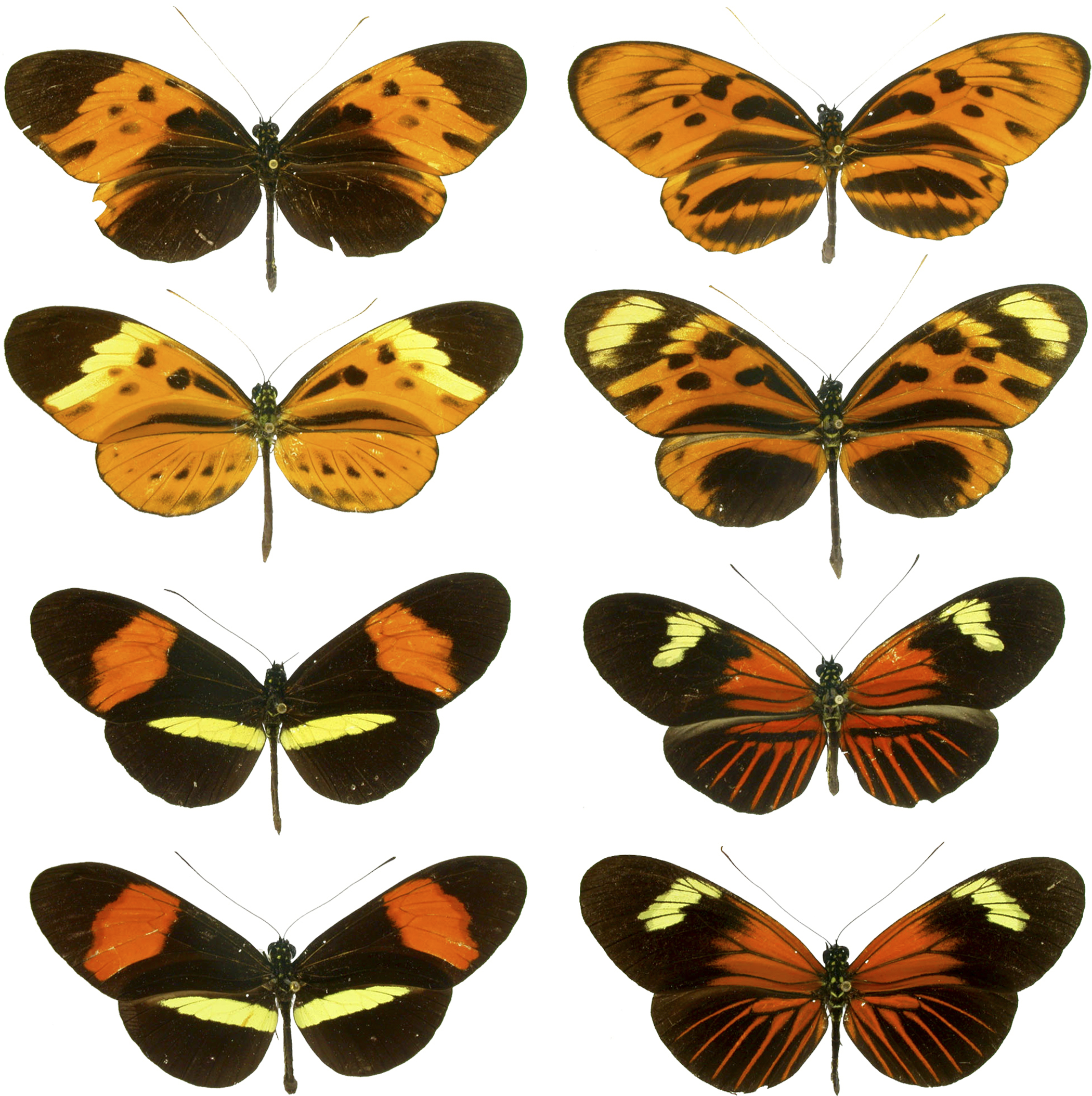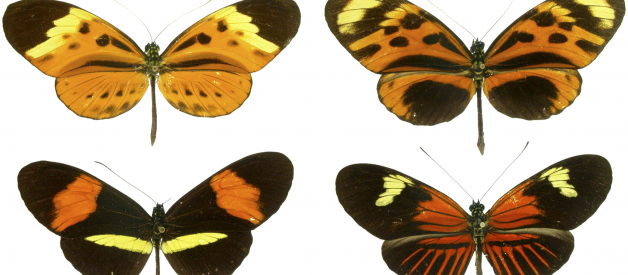?Imitation is the sincerest form of flattery that mediocrity can pay to greatness.?- Oscar Wilde
Mimicry can be found in many different aspects of life. Animals use mimicry for protection and survival, humans use mimicry to express emotion and respond to events and comedians use mimicry as a technique to familiarize their audience with their topics of discussion, in order to establish comfort.
 Heliconius Butterflies
Heliconius Butterflies
Mimicry is defined by Merriam Webster as ?the activity or art of copying the behavior or speech of other people: The activity or art of mimicking other people? (1).
We can accredit the first forms of mimicry to be found and recorded by Bates and Mller during their time working in Brazil. What they noticed was that many butterfly families had very similar colored wings but not exactly the same. They discovered that these butterflies mocked poisonous species that were undesirable to birds and lizards in order to protect themselves and survive. Around this same time, Darwin was exploring the idea of natural selection in his book ?On the Origin of Species.? Mller then wrote a response to his book which spoke in support of his theory and added this form of mimicry under a technique used for natural selection. (2)
Years after Mller?s findings, the term ?Mllerian mimicry? was coined. Before it was thought that the butterflies were mimicking the poisonous species, but it was later discovered that they were actually mimicking each other?s warning signs of other butterflies. Butterflies will adopt the features of butterflies that are able to survive and be avoided in order to survive. (3)
Mimicry is not limited to appearance, it extends to senses as well. For example ?snakes share the same auditory warning signals, forming an auditory Mllerian ring? (3). These signals can expand to closely related species and even species of different decent that have the same predators. This form of mimicry can be found all throughout different ecosystems dating back to the beginning of time.

What most people don?t know is that we use mimicking in our mannerisms to achieve certain goals. Just like butterflies, we are constantly adapting and changing in the presence of other human beings. We mirror and mimic one another to express emotions and increase likeliness of a positive feeling resulting from an interaction.

Subconsciously, we take each other?s posture or behavior. For example, a classic interview at a professional business firm. Beginning with the attire: An interviewee will most likely dress in accordance to what they think the administrator of the interview will be wearing. By mimicking dress code the interviewer has established a sense of familiarity with the employer. Let?s say, the interviewee shows up in a T-shirt and cargo shorts. Automatically, they have set a distinction between the two parties. This divide will not result in a comfortable setting and will lead one party to be superior over another one. To avoid awkwardness and to assimilate two parties mimicking of an outfit can change an entire situation.
Body language and gesture will also change during an interview. A firm handshake at the beginning of the meeting will signal a professional welcome automatically setting an expectation for the rest of the interview. From this point on, the interviewee will mirror the administrator of the test exactly. By sitting up straight, placing hands on the table or lap and even by matching the attitude of the room will be crucial to the interviewee?s success.
We, as humans have all of these techniques in order to try and succeed. The above scenario is an extreme example of how mimicking can be used to get ahead, but what about a simple uncontrollable yawn?

Mimicking can go as far as body movements such as yawning. Scientists have found that yawning can stem all the way to human empathy for one another. In a recent study, 40% of people will yawn at the site of another person yawning. Dr. Platek believes that this is an ?evolutionary trait that benefits our species.? Our ability to replicate body behavior has helped to ?bind social groups through their feelings for each other.?
As early as four years old, a child will pick up the trait of yawning. For reasons that are not quite explainable yet, we use yawning to bond to one another. It is suspected that yawning occurs between groups of people to help send a sense of calmness through a group and break social barriers. It rarely has to do with tiredness or being bored.
From a formal interview to yawning, mimicking is found in different forms of physical and emotional behavior in humans. Both of these examples result in the advantage of our species and that advantage is always the same. By mirroring body language we break down barriers between people and gain a mutual understanding and trust. Human complexity comes from our ability to pick up emotional and social cues from one another. Our constant use of mirroring and mimicking adds to our emotions and feelings and it is what makes us human.
 Tina Fey (Left) and Sarah Palin (Right)
Tina Fey (Left) and Sarah Palin (Right)
So now the question comes is how do artists such as comedians use their knowledge on mimicry to their advantage? In my essay discussing Tina Fey?s role as Sarah Palin I take a look into how each detail of her mannerisms represent a new image. Tina Fey copies Sarah Palin?s appearance, accent, and even behavioral mannerisms.
All of these tendencies together help create a sense of familiarity with our subject that is being made fun of. We can tune in to Saturday Night Live and automatically recognize the familiar figure on the screen. However, what we are seeing it not what we expect. It is a mockery of the real deal and that is what generates a laugh. Tina Fey uses her uncanny resemblance and a few techniques to trick her audience into believing something that isn?t real and once the audience realizes this discrepancy a laugh is formed.
In the opposite manner of a butterfly, Tina Fey attracts her audience towards her using mimicry as her main technique. As evidence listed above, there are many different ways that mimicry is used in nature. From warding off enemies to breaking social barriers mimicry is a natural phenomenon occurring in many stages of life.
A simple yawn can share an individual?s emotional side and the way a person acts in an interview can determine whether or not they will get a job. Lastly and most importantly, the main use of mimicry is used to assimilate together. Butterflies assemble together to protect themselves from predators while humans assimilate together to generate a positive feeling within. Recognizing these different forms of mimicry reveals how a small tendency to band together can go very far. It is important to show how these behaviors effect our population every day in order to advance.


